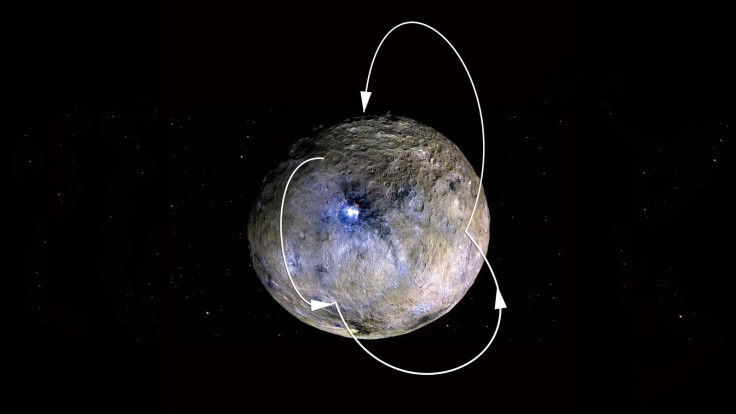Ceres News: Water Ice Is Everywhere On Dwarf Planet, Dawn Finds

NASA’s Dawn spacecraft arrived in orbit around the dwarf planet Ceres on March 6, 2015, and has been steadily collecting data about the largest body in the asteroid belt between Mars and Jupiter since. And while Dawn has already told us fascinating things about Ceres, new analysis of data shows the dwarf planet maybe extremely rich in water ice.
In fact, water ice may be everywhere on or near the surface of the dwarf planet, according to two separate lines of evidence presented by researchers at the ongoing 2016 Fall Meeting of the American Geophysical Union in San Francisco.
A study detailing the methodology and theory behind one line of reasoning was published Thursday in the journal Nature Astronomy. It cites prior proof of water vapor on Ceres, collected by Dawn and the Herschel telescope, as well as surface water ice seen by Dawn at Ceres’ mid-latitudes. And it posits that water molecules are cold-trapped in permanently shadowed regions in high latitudes, as happens on the moon and Mercury.
And the study’s authors base their theory on detecting, using spectroscopy, water ice deposit on the floor of a permanently shadowed crater, of which there are at least 634 on Ceres. “This detection strengthens the evidence that permanently shadowed areas have preserved water ice on airless planetary bodies,” the study says.
“We are interested in how this ice got there and how it managed to last so long,” study co-author Norbert Schorghofer of the University of Hawaii, said in a statement. “It could have come from Ceres’ ice-rich crust, or it could have been delivered from space.”
The second line of evidence was published Thursday as a study in the journal Science. It uses nuclear spectroscopy to determine that water within the interior of the dwarf planet affected the material on its surface. Studying the concentrations of hydrogen, iron and potassium on Ceres, as well as the regolith, researchers said in the study the concentration of hydrogen particles in the regolith at mid-to-high latitudes suggested “broad expanses of water ice, confirming theoretical predictions that ice can survive for billions of years just beneath the surface.”
“On Ceres, ice is not just localized to a few craters. It’s everywhere, and nearer to the surface with higher latitudes,” Thomas Prettyman, principal investigator of Dawn's gamma ray and neutron detector (GRaND), based at the Planetary Science Institute in Tucson, Arizona, said in the statement.
“These studies support the idea that ice separated from rock early in Ceres’ history, forming an ice-rich crustal layer, and that ice has remained near the surface over the history of the solar system,” Carol Raymond, deputy principal investigator of the Dawn mission, based at NASA's Jet Propulsion Laboratory, Pasadena, California, said in the statement.
The search for water and water ice is important because it is imperative for the existence of life as we know it. Finding it in places other than Earth could help us understand if life existed (or even exists) elsewhere in the solar system. Also, by learning more about water on celestial bodies that lack an atmosphere, scientists could better work toward devising ways to set up things such as lunar bases.
© Copyright IBTimes 2025. All rights reserved.





















